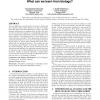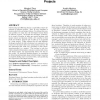1792 search results - page 167 / 359 » Multi-agent learning for engineers |
77
Voted
CCR
2010
14 years 10 months ago
2010
There is significant research interest recently to understand the evolution of the current Internet, as well as to design clean-slate Future Internet architectures. Clearly, even ...
76
Voted
TSE
2010
14 years 8 months ago
2010
—In this paper, we explore the concept of code readability and investigate its relation to software quality. With data collected from 120 human annotators, we derive associations...
IJRR
2011
14 years 5 months ago
2011
We present a novel approach to legged locomotion over rough terrain that is thoroughly rooted in optimization. This approach relies on a hierarchy of fast, anytime algorithms to p...
KBSE
2005
IEEE
15 years 3 months ago
2005
IEEE
To realize the benefits of Aspect Oriented Programming (AOP), developers must refactor active and legacy code bases into an AOP language. When refactoring, developers first need...
93
Voted
SIGSOFT
2010
ACM
14 years 8 months ago
2010
ACM
Outsourcing and offshoring lead to a rapid influx of new developers in software projects. That, in turn, manifests in lower productivity and project delays. To address this common...


